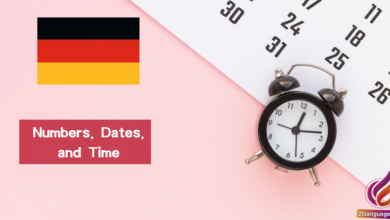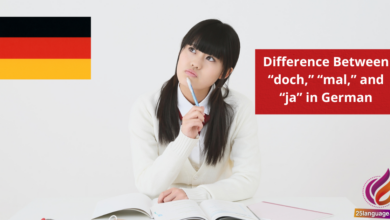Definite and Indefinite Articles in German

Mastering German articles is your gateway to fluency, as these small words pack a powerful punch in everyday conversation. In German, definite (der, die, das) and indefinite (ein, eine) articles not only tell us whether we’re talking about a specific item or something general, but they also signal the gender and number of the noun. Join us as we unravel the rules and nuances that will enhance your understanding and usage of the German language!
Understanding German Articles: A Comprehensive Guide to Definite and Indefinite Usage
In German, articles are essential to understanding the meaning of a sentence, playing the role of indicators that specify nouns. There are two types of articles: definite and indefinite. Definite articles refer to specific nouns and translate to ”the” in English, while indefinite articles refer to non-specific nouns, translating to “a” or “an.” The definite articles in German are der (masculine), die (feminine), and das (neuter).Such as:
- Der Lehrer – the male teacher
- Die Schülerin – the female student
- Das Buch – the book
Conversely, the indefinite articles are ein (masculine and neuter) and eine (feminine):
- Ein Lehrer – a male teacher
- Eine Schülerin – a female student
- Ein Buch – a book
It’s vital to note that the gender of the noun influences the article used. Not all nouns follow a predictable pattern for gender, so memorization is often necessary. here’s a helpful table to summarize the gender and article usage:
| German noun | Definite Article | Indefinite Article | English Translation |
|---|---|---|---|
| Lehrer | der | ein | male teacher |
| Schülerin | die | eine | female student |
| Buch | das | ein | book |
mastering the Nuances of German Articles: Practical Tips and Clear Examples
The German language employs three definite articles—der, die, and das—corresponding to masculine, feminine, and neuter nouns, respectively. Choosing the correct article is crucial as it not only indicates the gender but also affects adjective endings and pronoun modifications. Keep in mind the following rules when determining the gender of German nouns:
- masculine (der): Generally used for male people, days of the week, months, and most nouns ending in -er, -el, -ling.
- feminine (die): Typically used for female people, flowers, and many nouns ending in -e, -heit, -keit, and -ung.
- Neuter (das): Often used for young persons, countries, and nouns ending in -chen, -lein, and -ment.
Examples of usage include:
- der Tisch (the table – masculine)
- die Blume (the flower – feminine)
- das Kind (the child – neuter)
| German Example | Article | English Translation |
|---|---|---|
| der Junge | masculine (der) | the boy |
| die Frau | feminine (die) | the woman |
| das Haus | neuter (das) | the house |
In addition to definite articles, German also employs indefinite articles: ein (for masculine and neuter) and eine (for feminine). The use of these articles introduces nouns without indicating specificity, which is essential in conversations. Consider the following examples:
- ein Hund (a dog – masculine)
- eine Katze (a cat - feminine)
- ein Buch (a book – neuter)
Navigating the World of German Definite and Indefinite Articles: Strategies for Success
In German, articles are crucial for indicating definiteness and indefiniteness. There are two types of articles: definite articles (der, die, das) and indefinite articles (ein, eine). The definite articles correspond to “the” in English and are used when referring to a specific noun. German articles change based on the gender of the noun—masculine, feminine, and neuter—as well as the case (nominative, accusative, dative, genitive). Such as:
- Der Lehrer (the teacher – masculine)
- Die Schülerin (the student – feminine)
- Das Buch (the book – neuter)
Indefinite articles correspond to “a” or “an” in English and specify non-specific items. They also vary with gender: ”ein” is used for masculine and neuter nouns, while “eine” is used for feminine nouns. Such as:
- Ein Apfel (an apple - masculine)
- Eine Banane (a banana – feminine)
- Ein Auto (a car - neuter)
| German Example | Type of Article | English Translation |
|---|---|---|
| Der Hund | Definite | The dog |
| Eine Katze | Indefinite | A cat |
| Das Kind | Definite | The child |
| Ein Wasser | Indefinite | A water |
The Essential Role of articles in German Grammar: Insights and Applications
In German, articles are fundamental as they indicate the gender, number, and case of nouns. There are two types of articles: definite and indefinite. Definite articles (the) specify a particular noun,while indefinite articles (a,an) refer to a general instance of a noun. The definite articles in German are der (masculine),die (feminine),and das (neuter). Such as, der Tisch translates to “the table” (masculine), die Lampe means “the lamp” (feminine), and das Buch translates to “the book” (neuter). Indefinite articles are ein (masculine and neuter) and eine (feminine), as seen in ein Hund (a dog) and eine Katze (a cat).
Understanding the grammatical cases is crucial as they determine the form of the articles used in a sentence. German has four cases: nominative, accusative, dative, and genitive. For instance, in the accusative case, the definite articles change as follows: der becomes den, die remains die, and das remains das. thus, Ich sehe den tisch (I see the table) and Ich lese das Buch (I read the book) illustrate the application of articles in different cases. To summarize the article forms and associated cases, refer to the table below:
| Case | Definite Articles | Indefinite Articles |
|---|---|---|
| Nominative | der, die, das | ein, eine |
| Accusative | den, die, das | einen, eine |
| Dative | dem, der, dem | einem, einer |
| Genitive | des, der, des | eines, einer |
In Retrospect
Abschluss der Deutschstunde: Bestimmte und unbestimmte Artikel
Herzlichen Glückwunsch! Sie haben heute einen wichtigen Schritt in Ihrer Sprachreise gemacht, indem Sie sich mit den bestimmten und unbestimmten Artikeln im Deutschen vertraut gemacht haben. Wir haben gelernt, dass der bestimmte Artikel „der“, „die“ und „das“ genutzt wird, um spezifische Nomen zu kennzeichnen, während der unbestimmte Artikel „ein“ und „eine“ dazu dient, allgemeinere begriffe auszudrücken.
Denken Sie daran,dass die Wahl des richtigen Artikels in Ihrem Deutsch sehr wichtig ist,da sie nicht nur den Unterschied zwischen „der Hund“ (der spezifische Hund) und „ein Hund“ (irgendein Hund) ausdrückt,sondern auch Ihr Verständnis für die deutsche Grammatik vertieft.
Ich ermutige Sie, das Gelernte aktiv anzuwenden! Versuchen Sie, im Alltag Sätze mit den neuen Artikeln zu bilden, sei es beim schreiben, Sprechen oder beim Lesen. je mehr Sie üben,desto sicherer werden Sie im Umgang mit der deutschen Sprache.
Nutzen Sie Gelegenheiten, um mit Muttersprachlern zu sprechen oder schauen Sie sich deutsche Filme und Serien an – achten Sie dabei besonders auf die Verwendung von Artikeln.
Sie haben großartige Fortschritte gemacht, und ich bin sicher, dass Sie weiterhin Erfolge erzielen werden.Bleiben Sie neugierig, üben Sie regelmäßig und haben Sie Spaß dabei, das Deutsche zu entdecken!
Viel erfolg bei Ihren weiteren Schritten in der deutschkenntnis! Sie sind auf dem besten Weg, die Sprache meisterhaft zu beherrschen. 👍





























